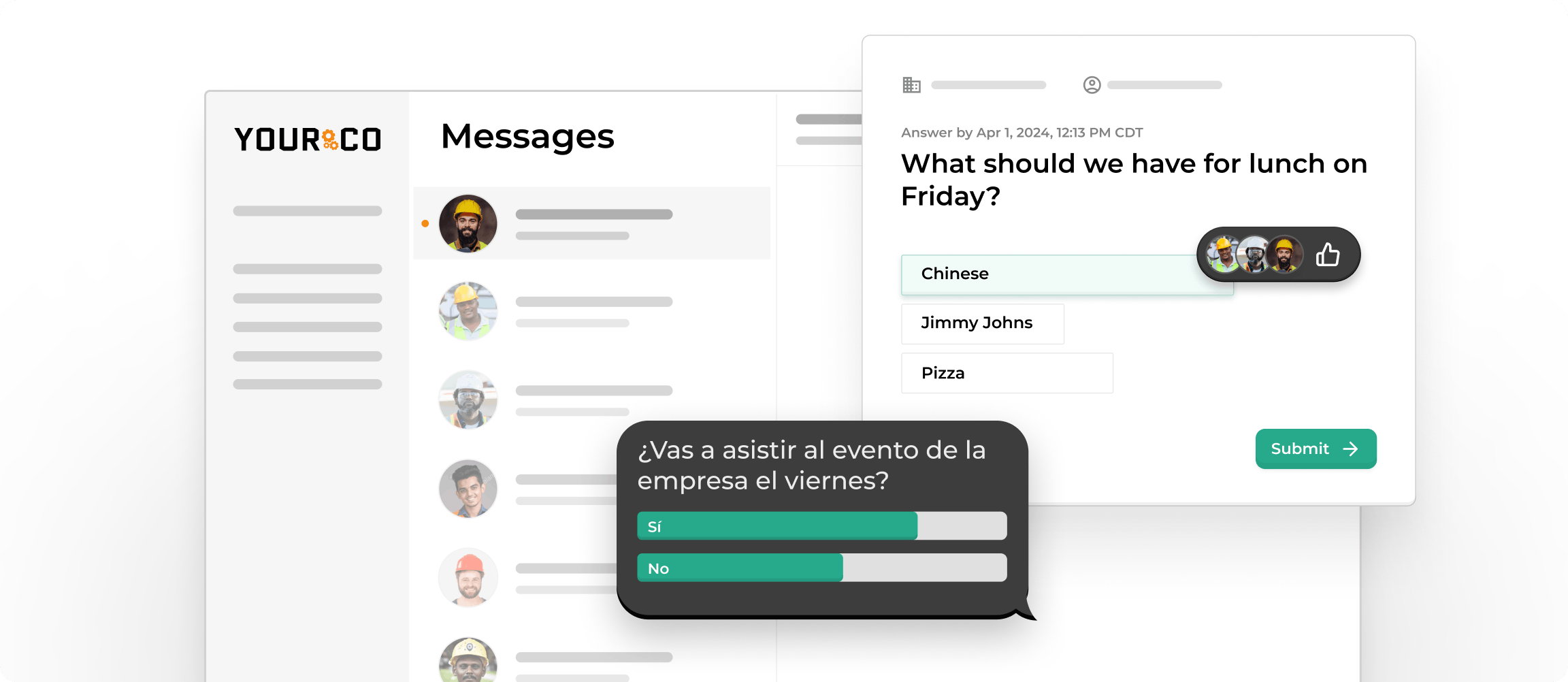Solving Inconsistent Communication: A Guide for Food & Beverage Operations


Communication breakdowns in the Food and Beverage industry cost more than missed messages, as they create safety risks, waste money, and drive away good employees. Your team works across shifts, locations, and languages in restaurants, hotels, catering operations, and bars, but critical updates about schedules, safety protocols, and daily operations often never reach the people who need them most.
Unlike office environments where email and apps work fine, food service teams need communication solutions that cut through kitchen noise, work for employees without smartphones, and deliver urgent information instantly. Whether you're managing a restaurant chain, hotel food service, catering company, or bar operations, reliable communication directly impacts your bottom line.
This guide reveals practical strategies that smart food and beverage operators use to keep their entire team informed, engaged, and working together effectively across all service environments.
The Hidden Costs of Poor Food & Beverage Communication
Food service communication failures create cascading problems that extend far beyond missed messages. When information doesn't reach the right people at the right time, operations face delays, safety risks, and frustrated teams that directly hurt profitability.
Money Walking Out the Door
Poor communication hits food and beverage finances in multiple ways:
- Lost sales opportunities: Servers who miss menu updates can't upsell effectively or provide accurate information to customers. Hotel room service staff unaware of kitchen limitations disappoint guests with incorrect availability.
- Wasted ingredients and time: Kitchen staff working with outdated prep lists create unnecessary food waste. Catering teams preparing wrong quantities for events lose hundreds in ingredients and labor costs.
- Inflated labor costs: Schedule confusion leads to overtime pay, double coverage, or short-staffed shifts during peak hours. Bar managers calling multiple staff members for last-minute coverage wastes valuable time.
- Management inefficiency: Hours spent on phone calls for shift coverage could be used for revenue-generating activities like menu planning, staff development, or customer relationship building.
- Food waste from miscommunication: Wrong prep amounts, missed special dietary requests, or catering mistakes cost significant money and damage customer relationships.
Safety and Compliance Risks
Food service operates in high-pressure environments where safety communication can prevent serious accidents. When cleaning staff don't know about wet floors, servers aren't aware of allergen updates, or kitchen teams miss critical food safety protocols, the results can be devastating.
Health department violations from communication breakdowns can trigger fines, temporary closures, or permanent reputation damage. Temperature log requirements, cleaning schedules, and safety training updates must reach every team member consistently across restaurants, hotels, catering kitchens, and bar operations.
Emergency situations require immediate, clear communication to all staff. Whether it's a kitchen fire, medical emergency, or severe weather, every employee needs to know what's happening and how to respond safely.
Team Turnover and Morale Issues
Food service employees who feel disconnected from communication often feel undervalued and disconnected from their workplace. This is especially true for back-of-house staff who rarely interact with management during busy service periods.
When employees hear about schedule changes, policy updates, or company news through rumors instead of official channels, trust erodes quickly. Staff members who consistently miss important information may feel set up to fail, leading to frustration and eventual departure.
Recognition and feedback also suffer when communication channels don't work. Acknowledging good performance, sharing positive customer reviews, or celebrating team achievements becomes nearly impossible without reliable ways to reach everyone across different service locations.
Common Communication Breakdowns in Food Service
Food and beverage communication problems often stem from the industry's unique operational structure. Understanding these specific challenges helps identify where improvements will have the biggest impact.
The Shift Handoff Challenge
Information frequently gets lost during shift changes when tired employees rush to leave and incoming staff miss crucial updates. Verbal handoffs work fine for simple updates, but complex information about special events, equipment issues, or staffing changes often gets garbled or forgotten entirely.
Written notes posted in break rooms or near time clocks create bottlenecks, with employees crowding around to read updates. Important information gets buried under routine announcements, and there's no way to confirm who saw what messages.
Different shifts develop their own communication styles and informal channels, creating information silos between morning, afternoon, and evening teams. Day managers may have no idea what challenges night crews face, and vice versa. This problem multiplies across hotels with 24-hour room service, catering operations with early morning prep, and bars with late-night cleanup.
Multi-Location Coordination Problems
Food service chains and franchises struggle to maintain consistent communication across locations. Corporate updates intended for all sites may reach some managers but never make it to frontline staff. Individual locations develop their own communication approaches, creating inconsistency in how policies are implemented.
District managers visiting multiple restaurants, hotel properties, or catering facilities often find that the same policy is being interpreted and executed differently at each site. Training materials, safety updates, and operational changes get communicated through different channels, leading to confusion about which version is current.
Cross-location coverage during busy periods becomes complicated when staff from different operations can't easily coordinate schedules or share important operational details.
Language and Cultural Barriers
Many food service operations employ diverse teams where English may not be everyone's primary language. Important safety information, policy changes, and training materials delivered only in English leave some team members partially or completely uninformed.
Cultural differences in communication styles can also create gaps. Some employees may hesitate to ask questions or report problems due to cultural norms about hierarchy and authority. Others may not feel comfortable using written communication channels.
Management often struggles to accommodate multiple languages while maintaining consistent messaging. Translating important documents takes time and resources, and there's often no way to verify that translations are accurate or understood.
Build Reliable Communication Systems for Food & Beverage Operations
Effective food service communication requires simple, accessible systems designed for fast-paced environments across restaurants, hotels, catering, and bar operations.
Choose the Right Communication Channels
Different types of information require different communication approaches. Urgent updates like safety alerts or immediate schedule changes need channels that reach people instantly and get immediate attention. Routine information like policy reminders or training materials can use channels that allow people to review information when convenient.
Text messaging works exceptionally well for food service teams because:
- Universal accessibility: Works on any phone, including basic models that some food service employees prefer across all operation types
- High engagement: Achieves 98% read rates, making it reliable for time-sensitive information in busy restaurant, hotel, catering, and bar environments
- No barriers: Unlike apps that require downloads or logins, text messaging uses familiar interfaces
- Instant delivery: Reaches people immediately without waiting for them to check email or apps
- Two-way capability: Allows employees to ask questions, confirm information, and report issues in real-time across all service locations
Visual communication through photos can be incredibly effective for food operations. Kitchen staff can share pictures of proper food presentation, maintenance issues, or inventory needs. Managers can send photos of new menu items, equipment setup, or cleaning standards to ensure consistency across shifts and locations.
Two-way communication channels allow employees to ask questions, confirm receipt of information, and report issues in real-time. This creates feedback loops that help managers stay informed about frontline challenges and verify that important messages are understood.
Design Messages for Maximum Impact
Food service communication needs to be clear, concise, and action-oriented. Employees scanning messages between tasks need to understand the key information immediately. Start with the most important information first, then provide supporting details.
Use everyday language that works for your entire team. Avoid industry jargon that might confuse newer employees, and be especially mindful of language complexity when your team includes non-native English speakers working across restaurants, hotels, catering operations, and bars.
Include specific details that prevent confusion. Instead of "kitchen equipment issue," specify "oven #2 not heating properly - use convection oven for all baked items." Instead of "schedule change," provide "Maria covering for John on Saturday dinner service, 5pm-close."
Visual elements like photos, simple diagrams, or even emojis can help convey information quickly and clearly. A photo of proper uniform standards communicates more effectively than written descriptions across different service environments.
Create Feedback Loops and Confirmation Systems
Build systems that allow you to verify important messages were received and understood. For critical safety information, policy changes, or schedule updates, implement simple confirmation processes.
Quick response mechanisms like "Reply YES to confirm you received this message" create records of who saw important information. This documentation becomes valuable for training, compliance, and performance management across all food service operations.
Regular check-ins through brief surveys or pulse polls help gauge overall communication effectiveness. Simple questions like "Are you receiving the information you need to do your job well?" provide insight into communication gaps.
Encourage questions and clarification requests. Create safe channels for employees to ask for help understanding policies, procedures, or expectations without fear of judgment.
Overcome Food Service-Specific Communication Barriers
Food and beverage environments present unique obstacles that generic communication solutions often can't address. Successful systems account for noise, time pressure, language differences, and varying technology comfort levels.
Work Around Noise and Distractions
Food service environments are naturally loud and chaotic during service periods. Communication methods that work in quiet office settings may be completely ineffective during dinner rush, busy breakfast service, or crowded bar operations.
Text-based communication offers clear advantages in noisy food service environments:
- Cuts through noise: Staff can read messages during brief breaks rather than trying to hear announcements over kitchen noise, blenders, espresso machines, and customer conversations
- Visual alerts work better: Phone notifications draw attention more effectively than audio alerts that get lost in loud restaurant, hotel, catering, or bar environments
- Available anytime: Messages wait for recipients and can be reviewed multiple times, unlike verbal announcements that only reach people present at that moment
- No disruption: Simple vibration alerts notify employees about urgent messages without disturbing customers or other staff
Support Diverse Language Needs
Food service operations with multilingual teams need communication systems that work for everyone, regardless of English proficiency. Automatic translation features can convert important messages into employees' preferred languages, ensuring safety information and policy updates are understood by everyone.
Simple, clear language helps all employees, including native English speakers. Avoiding complex vocabulary and industry jargon makes messages more accessible and reduces misunderstandings.
Visual communication helps bridge language gaps. Photos of proper procedures, safety equipment, or food standards communicate effectively regardless of language barriers. Combining images with translated text creates redundant communication that improves comprehension.
Encouraging questions in any language creates safer communication environments. When employees can ask for clarification in their preferred language and receive responses they understand, important information is more likely to be properly implemented.
Accommodate Different Technology Comfort Levels
Not all food service employees are comfortable with complex technology or smartphone apps. Effective communication systems work for everyone, from tech-savvy young servers to experienced cooks who prefer simple tools.
Text messaging requires minimal technical skills and works on phones people already own and use. Unlike specialized apps that require training and ongoing updates, texting uses familiar interfaces that don't create barriers to communication.
Simple response options like "Reply 1 for YES, 2 for NO" make it easy for anyone to participate in surveys or confirm receipt of messages. Complex interfaces with multiple buttons, login requirements, or navigation menus create obstacles that prevent participation.
Provide basic support for employees who need help with new communication systems. Peer mentoring often works better than formal training sessions, allowing comfortable employees to help others learn new tools.
How to Implement Better Food Service Communication
Moving from communication problems to effective systems requires practical steps that work within food service operational constraints. Start with high-impact changes that address your biggest pain points, then expand the system as your team becomes comfortable with new approaches.
Start with Critical Communication Needs
Identify the communication breakdowns that cause the most operational problems or safety risks. Focus initial improvements on these high-priority communication areas:
- Schedule changes and shift coverage: Implement reliable systems for communicating schedule updates, finding coverage for call-outs, and confirming shift assignments across all service locations
- Safety alerts and emergency information: Ensure all employees can receive immediate notifications about equipment problems, safety hazards, or emergency procedures
- Daily operational updates: Share menu changes, specials, inventory needs, or equipment issues with relevant team members promptly across restaurants, hotels, catering operations, and bars
- Compliance documentation: Track that safety information reached everyone for regulatory compliance purposes
Build Manager Buy-In and Training
Communication improvements succeed when managers at all levels understand and use new systems consistently. Train supervisors, shift leaders, and assistant managers on new communication tools and protocols.
Demonstrate how better communication solves problems managers face daily. Show how quick text updates can prevent the frustration of calling multiple employees to find shift coverage, or how instant notifications about equipment problems can prevent service delays during busy periods.
Create simple protocols for different types of messages. Establish who sends what information, when to use different communication channels, and how to handle responses or questions. Clear guidelines prevent confusion and ensure consistency.
Set expectations for response times and message acknowledgment. Help managers understand when immediate responses are necessary and when employees can reply within a few hours.
Measure and Adjust Your Approach
Track metrics that show whether communication improvements are working. Monitor response rates to important messages, time required to handle shift coverage, and employee feedback about information accessibility.
Ask employees directly about communication effectiveness through brief surveys or informal conversations. Find out what information they need but aren't receiving, and identify barriers that prevent them from accessing or understanding messages.
Adjust your approach based on results and feedback. If certain types of messages consistently get low response rates, experiment with different wording, timing, or communication channels.
Document what works well so you can replicate successful approaches for similar situations. Create templates for common messages like schedule changes, safety alerts, or policy updates to maintain consistency while saving time.
Transform Food Service Communication Chaos into Seamless Operations with Yourco
Food and beverage communication doesn't have to be complicated or unreliable. Yourco transforms how restaurants, hotels, catering companies, and bars connect with their teams through simple SMS-based communication that works for everyone, from experienced managers to new hires who speak different languages.
With Yourco, your entire team receives important updates instantly on phones they already own and use. No apps to download, no passwords to remember, no training required. Send schedule changes, safety alerts, or daily updates with confidence across all your service locations.
The platform automatically translates messages into over 135 languages and dialects, ensuring every team member understands safety protocols, policy updates, and operational information regardless of their primary language. Two-way communication allows employees to ask questions, confirm shifts, or report problems directly through text, creating feedback loops that keep managers informed about frontline challenges.
Yourco integrates seamlessly with food service scheduling and HR systems, automatically updating employee groups and contact information. Managers can send targeted messages to specific shifts, locations, or departments, ensuring the right information reaches the right people without overwhelming anyone with irrelevant updates.
Try Yourco free today or schedule a demo and discover how simple, reliable communication can transform your food and beverage operations.
Frequently Asked Questions
How can food service operations improve communication without overwhelming employees with too many messages?
Focus on essential information that directly impacts employees' work or safety. Use segmented messaging to send relevant updates only to affected team members, kitchen staff don't need front-of-house schedule changes, and day shift employees don't need overnight cleaning reminders. Establish clear protocols about what information warrants immediate communication versus what can wait for shift meetings or posted updates.
What's the best way to handle communication in food service with high employee turnover?
Create simple, repeatable communication processes that don't rely on specific individuals to relay information. Use systems that automatically update employee contact information and group assignments when new hires join or staff members leave. Document important procedures and safety protocols in easily accessible formats so new employees can quickly get up to speed on communication expectations.
How do food and beverage operations effectively communicate with employees who speak different languages?
Use communication platforms like Yourco that automatically translate messages into employees' preferred languages, ensuring safety information and operational updates are understood by everyone. Combine text with visual elements like photos or diagrams when possible. Create a culture where employees feel comfortable asking questions in any language, and provide responses in ways they can understand.
What types of food service communications should be immediate versus what can wait?
Immediate communication should include safety hazards, equipment failures that affect service, emergency situations, and urgent schedule changes. Routine information like policy reminders, training announcements, or general company updates can be scheduled for less busy times. Always prioritize safety and operational information that affects the current shift.
How can food service managers verify that important safety information reached all employees?
Use communication systems that allow simple confirmation responses, like "Reply YES to confirm you understand this safety update." Keep records of who received and acknowledged critical safety information for compliance documentation. Follow up with employees who don't respond within a reasonable timeframe to ensure the information reached them and they understand the requirements.




